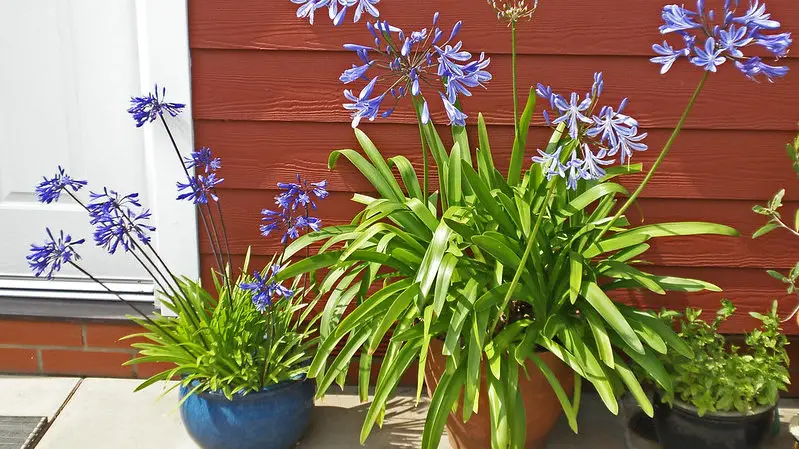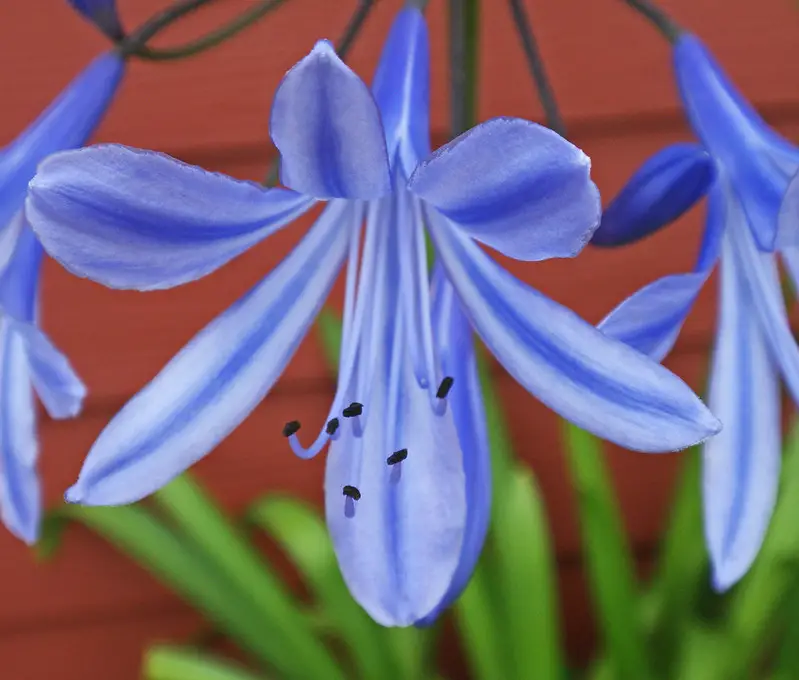We use affiliate links to run our site. When you buy through links on our site, we may earn an affiliate commission, without any added cost to you. Learn more
Lily of the Nile” or “African lily” is a perennial herb that has funnel-shaped flowers, with a diameter of 2.5-5 cm. These beautiful flowers can add a splash of colours to a flower bed and brighten up your indoors.
They are pretty easy to grow and with a little bit of guidance, you can too bring the magic of the Caribbean in your own garden.
The scientific name of the Lily of Nile is Agapanthus africanus
Types and varieties:
Some of the most popular types of Agapanthus plants are:
Agapanthus orientalis: This is the most common type of agapanthus you will come to see. They have wide, arching leaves and stems that reach heights of 1 to 1.5 m. They produce white and blue flowers.
Agapanthus campanulatus : They have strappy leaves and produce dark blue flowers. These are deciduous in nature.
Agapanthus africanus: These types produce deep blue flowers and narrow leaves. the stalks reach a maximum height of 45 cms.
How to Propagate Agapanthus:
You can propagate Lily of the Nile by two ways.
- From Seed, and
- By root division
How to Propagate Agapanthus From Seeds:
You can also grow a Lily of the Nile through seeds. Sow the seeds indoors in a warm environment. The ideal temperature should be around 70-80°F. Use a seedling tray like this to grow seedlings indoors.
First, put some seed starter mix in each seed pocket and then place one or two seeds on top of the mix. Now cover the seeds with a bit of the mix.
Till the germination happens keep the mix warm and moist. Place a heat mat under the seedling tray to keep it warm.
It would take 2 weeks for the seeds to germinate. Once the seedlings grows three to four true leaves, transplant them to your desired place.
The best part of growing seeds indoors are:
- No matter which temperature zone you live you can germinate the seeds.
- The seeds will also be protected from outside critters.
How to Propagate Agapanthus By Root Division:

A root division is a clone of the plant. You can buy them from your local nursery and start propagation. If you particularly love a cultivar and want to have a replica of the plant in your house then root division is the way to go.
Most cultivars remain dormant in the winters so it will take a little to show any new growth. Always use gloves while working with Agapanthus roots or else it may cause irritation.
For preparing your own root division dig six to eight inches deep around the outside of an existing clump. Then with the help of a sharp knife cut the tuberous root ball in half without injuring any new growth. Cut them once more to make 4 pieces each with at least one shoot attached with them.
Keep the pieces in a place outside the reach of direct sunlight for a day. This will help to form a protective layer around the wound that will protect the root from getting rot.
Now, dig a hole large enough to fit the root ball. Now put the root inside the hole and cover the hole with soil or growing medium. Cover it in a way so that nothing remains above the ground.
Growing Lily of the Nile in Containers:
You can easily grow Lily of Niles in pots. Use soil that is well-drained and mix some slow releasing fertilizers with the soil.
Agapanthus likes a little root-bound condition for thriving. If the pot is too large it will encourage leaf growth rather than flower formation. So make sure you choose a pot in a way so that the plant’s root development is restricted but it gets proper watering and nutrition. Ideally, a 6-8 inches pot works great for Agapanthus.
Feed the plant with a balanced liquid feed during the whole growing season. Stop only once you see the flowers.
During winter bring your Lily of the Nile inside the house especially if you live in cooler climates to protect them from extreme cold. Once the frost is over put them back outside.
Ideal Growing Conditions:
Light:
Agapanthus need full sun and too much shade can ruin the flowering process of your beloved plant. They generally cope well in extended heat waves and droughts. But the leaves and flowers can get burnt if the temperatures exceed 40°C.
Growing Soil:
Agapanthus prefers soil that is well-aerated, evenly moist and light. If you want to use garden soil add sand and peat moss or coir to ensure good drainage.
The best option for growing Lily of the Nile would be to use a balanced well-aerated houseplant mix like this one. It drains quickly so you will never have to worry about overwatering your plants.
pH:
The ideal soil pH should be slightly acidic (5.5 to 7) for growing Agapanthus. Do a soil test with a pH testing tool like this. If the pH is on the higher side, reduce the pH with these methods. If the soil is too acidic use these methods to bring down the acidity level of the soil.
Ideal Location for Growing Agapanthus:
You can grow Agapanthus in full sunny (in cooler area) to partly sunny (in warmer areas) location.
Some of the best locations for growing Lily of the Nile would be garden edges, driveways, and patios. You can also place them to highlight landscapes like rock gardens, ponds, rain gardens etc.
Fertilizer:
Although they don’t like too much fertilizer, Agapanthus loves nutrient-rich soil. Give them enough nutrients and they will grow more quickly and flower more prolifically. Use a general-purpose houseplant fertilizer like this one to fertilize the plants.
Feed your plants in springs and give a little bit of fertilizer monthly and they will be fine.
How To Water:
Avoid waterlogging. Even a little bit of waterlogging can rot those sensitive roots of an agapanthus. But don’t worry, they store water within the rhizomes and can easily cope with temporary drought.
start watering the plant regularly in April till June to wake the plant from “hibernation”. Then reduce the watering frequency till autumn. And finally, stop watering altogether in winters.
Pruning Agapanthus:
Pruning is very important for your Agapanthus if you want to prevents them from becoming invasive and stay healthy.
Once the flowers start to die, remove them and stop them from going to seed. If the seed pods are already here then remove the entire head so that the seeds don’t spread everywhere.
If you find yellow or dead leaves chances are the roots may be too congested and you might have to divide the plant.
Generally, you have to divide deciduous agapanthus every six to eight years, and evergreen types in every four to five years.
Use a pair of pruners and some good quality gardening gloves to do the pruning.
Pest and Diseases:
Usually, Lily of the Nile is not very susceptible to pests and diseases. The problem only occurs if the soil remains very wet for a longer period. It can cause fungal problems as well as leaf spot diseases. You can keep these problems away by simply using well-drained soil for growing Agapanthus.
Sometimes you may find slugs and snails chewing your plants. This though is not fatal it can damage the overall growth of the plant.
Remove them manually with hands or use organic pest control techniques to keep them away.
Hardiness:
Deciduous varieties are quite comfortable in areas with cooler winter temperatures. So they can live in Hardiness Zones from 6-11. Evergreen varieties, on the other hand, suffer in any type of cold and are best survive in Zones 8-11.
Aftercare:
It may take two or three years for plants to establish before flowering starts happening. But once it starts they will continue flowering for a long time.
Agapanthus can stop flowering if they remain in a drought condition after flowering. So keep the soil moist till the flowers start to fade. This will encourage new flower buds to grow. Use mulch to preserve the soil moisture and also to protect the plant from cold.
Agapanthus Flowers:
Agapanthus plants can reach up to a height of 4 feet at maturity and generally flowers in the months from June to August.
Agapanthus flowers make an eye-catching addition to any cut flower arrangement and the seed heads can be dried for year-round enjoyment.
- Make sure the plants get plenty of sunlight
- Provide organically rich, well-draining soil.
- Water one inch a week until established, and then slow to half an inch.
- Keep your potted Agapanthus in a mildly root-bound condition to get a beautiful bloom.
- If you are planning to grow Agapanthus in the garden they can be very prone to frost damage during winters. This is due to their fleshy roots and leaves. To prevent that from happening, spread a thick layer of mulch when young plants are exposed to winter. Also, plant them in garden beds and that too against a house wall. It will drastically reduce the chances of frost damage.
- Always wear gloves while handling the Agapanthus plant as they cause irritation to sensitive skin. They are also poisonous if ingested.
If you like this post, Don’t Forget to PIN IT.

Amazon and the Amazon logo are trademarks of Amazon.com, Inc, or its affiliates.

Hi there! My name is Prasenjit and I’m an avid gardener and someone who has grown a passion for growing plants. From my hands-on experience, I have learned what works and what doesn’t. Here I share everything I have learned.
